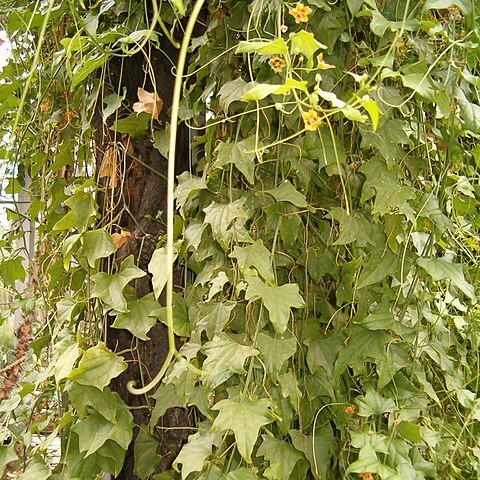Dioecious, perennial climber, flattened tuberous rootstock, up to 1 m in diam. Stems up to ± 10 m long, becoming woody. Leaves subsucculent, glabrous, outline ovate, cordate, 2-8 x 2-8 mm, unlobed or palmately 3-7-lobed; lobes triangular, central largest; petioles 10-40 mm long. Tendrils apically 2-fid. Male flowers 2-7 in ± sessile, axillary fascicles; pedicels 5-30 mm long; receptacle tube 0.5-1.0 mm long; lobes ovate, 2-3 mm long; petals 4-7 mm long, brownish, unequal. Female flowers 1 or 2, axillary; pedicels 10-20 mm long. Flowering time mainly Dec. Fruit an obconic-cylindric, trigonous capsule, 43-65 x 14-22 mm, dry, brownish, smooth, glabrous, dehiscent by an apical triradiate slit. Seeds compressed, linear-oblong, verrucose, broad, apical membranous wing, 30-55 mm long.
male flowers 2–7 in corymbiform axillary fascicles; peduncles c. 2 mm. long, obsolescent; pedicels 5–30 mm. long. Receptacle-tube 0·5–1 mm. long; lobes 2–3 mm. long, ovate, obtuse to rounded. Petals 4–7 mm. long, brownish, unequal, 2 rather larger and darker, 3 smaller and paler; anther-connective slightly produced beyond the thecae but not obviously appendaged.
Leaf-lamina 2–8 × 2–8 cm., ovate to broadly ovate in outline, cordate, subsucculent, glabrous, unlobed or palmately 3–5–7-lobed; lobes triangular, obtuse, apiculate, the central largest, ± acuminate, sometimes acute.
Seeds with compressed verrucose linear-oblong body and broad wing, 29–55 mm. long; body 16–25 × 4–7 mm.; wing 15–30 × 7–14 mm.
Scandent to 20 m. or more, stems becoming woody when old, arising from flattened tuberous rootstock up to 150 cm. across.
Fruit 4·3–6·5 × 1·4–2·2 cm., cylindric-obconic, smooth, glabrous, obscurely veined.
Female flowers 1–2, axillary; pedicels 1–2 cm. long; ovary c. 15 × 2–2·5 mm.
Petiole 1–4 cm. long, glabrous.

